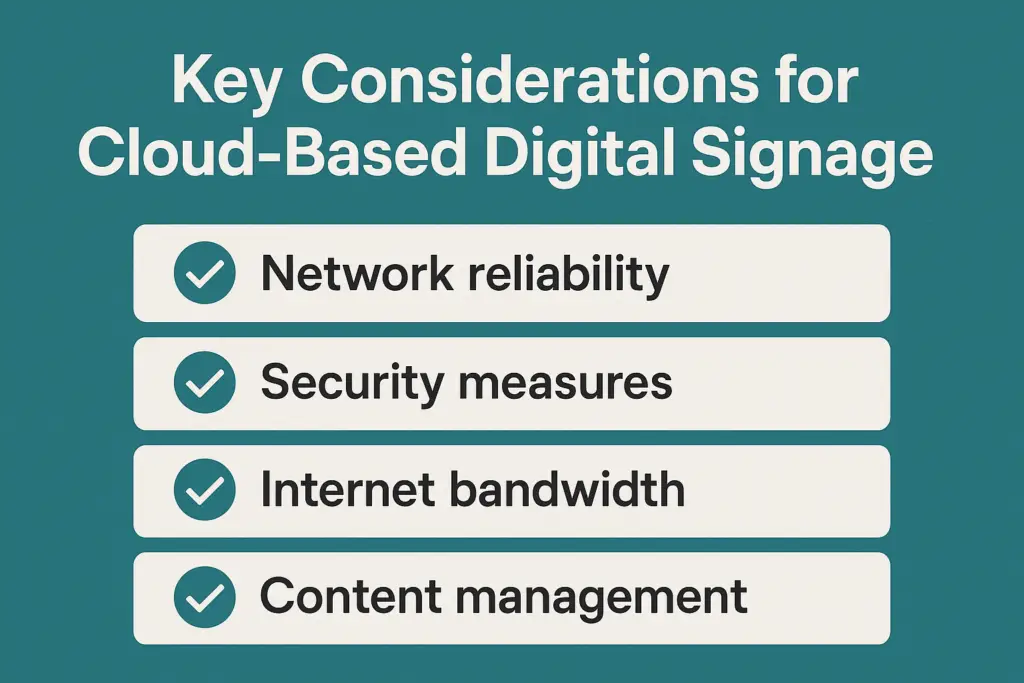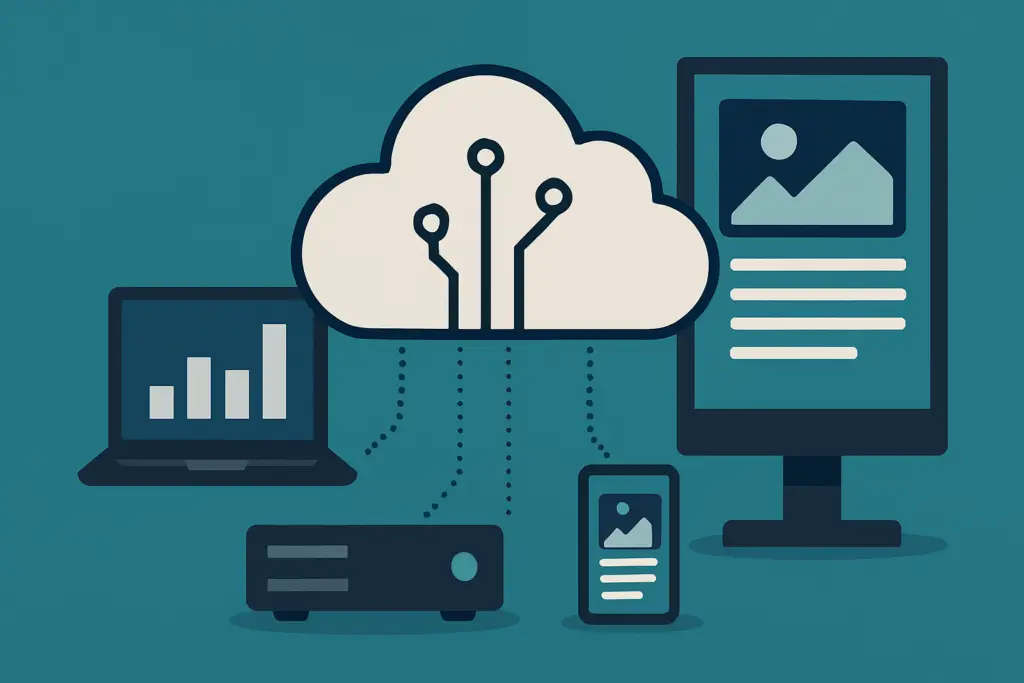Let’s be brutally honest: if your digital signage network still needs a dusty backroom server and a guy named Brad to “reboot it real quick” every time something crashes, 2025 is going to hit you like a freight train.
Cloud-based digital signage is no longer some fancy, “nice-to-have” tech for big brands with bigger wallets. It’s become the new baseline for how smart, scalable, future-proof digital signage actually gets done.
Here’s why clinging to your on-prem CMS in 2025 is like insisting your flip phone “works just fine,” and what you can do to move into the future.
What Is Cloud-Based Digital Signage Anyway?
Quick reality check: “cloud-based” means your digital signage software runs on servers you don’t have to touch, maintain, or pay to upgrade. You access it through a web browser or app, and your content lives securely online, not in a server rack guarded by Brad.
Key perks:
Instant remote access to screens from anywhere.
Real-time content updates.
Automatic software upgrades and patches.
Disaster recovery baked right in.
(And no, “cloud-based” does not mean “sketchy” or “insecure.” More on that in a sec.)

Benefits of Switching to Cloud Based Digital Signage
Talking theory is fine, but what does cloud-based signage actually do for real businesses? Here’s how different industries are already winning big by making the switch.
1. Retailers: National retail chains now update promotions across 500+ stores in under an hour, instead of spending days coordinating local techs.
2. Healthcare Facilities: Hospitals push emergency messages and patient information updates instantly without requiring on-prem IT interventions.
3. Quick-Service Restaurants: Franchise owners roll out breakfast menu updates systemwide by 5:00 a.m., avoiding lost sales from outdated displays.
4. Universities: Campus communications update across multiple buildings in minutes, from event announcements to emergency alerts.
5. Airports and Transit Hubs: Flight info and advertising updates are managed centrally, even when operations are stretched across multiple cities.
What Cloud-Based Costs (and Saves) vs. On-Prem
“But it must be expensive!” is usually the first objection I hear when suggesting cloud digital signage. Let’s talk cold, hard cash. The kind that either stays in your budget or gets sacrificed to the IT gods of yesteryear. The math isn’t even close.
On-Prem Setup Example:
$20,000+ server hardware.
$5,000 annual software maintenance.
$80,000/year IT staff overhead.
Downtime: countless frustrated hours.
Cloud-Based Setup Example:
$200-$500 per month SaaS license.
Minimal or no extra IT staff needed.
Instant scalability and security.
Savings Over 5 Years: Easily over $150,000, not counting saved stress and opportunity cost.
Book a free consultation today
Why Cloud-Based Is Winning in 2025
The digital signage market has spoken, and the verdict is overwhelming. Cloud adoption rates have tripled in just 24 months, leaving on-prem systems looking like fax machines in an email world. Here’s why cloud isn’t just winning, it’s delivering a knockout punch.
1. Speed and Scale Without Headaches Want to launch a promo across 500 locations tomorrow? Good luck manually patching every player onsite. With cloud CMS, you push updates globally with a few clicks. No travel, no late-night VPN battles.
2. Cost Savings (and Sanity Savings) Forget expensive servers, in-house IT maintenance, and upgrade cycles. With cloud digital signage, you’re paying for software-as-a-service (SaaS). Predictable monthly costs, no surprise hardware bills.
3. Remote Management Is Mandatory Now Post-2020, if you can’t troubleshoot and update signage remotely, you’re asking for operational nightmares. Cloud-based platforms allow real-time monitoring, alerts, and content swaps without sending someone onsite.
4. Automatic Updates and Security Modern cloud platforms roll out security patches and features automatically. Compare that to legacy setups where outdated software (and the vulnerabilities that come with it) quietly rot in your server room.
5. Smarter, More Dynamic Content Cloud platforms integrate more easily with third-party tools (think CRM systems, weather feeds, inventory data). This means dynamic, personalized content without Frankenstein-style IT workarounds.

Top 3 Myths About Cloud-Based Signage (and Why They're Wrong)
Of course, no good tech trend comes without its skeptics. Let’s clear the air on the biggest myths I hear, and why they’re dead wrong today.
Myth #1: “Cloud-Based Means More Downtime.” Reality: Most major cloud CMS providers offer 99.99% uptime SLAs. If your on-prem server fails, you’re out of luck until IT can fix it.
Myth #2: “It’s Not Secure.” Reality: Leading cloud CMS systems have stronger security certifications and active monitoring than most internal networks.
Myth #3: “It’s More Expensive Over Time.” Reality: Factoring maintenance, IT labor, and system upgrades, cloud-based typically wins in a 3-5 year TCO (Total Cost of Ownership) analysis.
But Isn't Cloud Risky?
Sure, if you’re living in 2008. Let’s address the lingering paranoia that keeps some organizations clinging to their ancient server racks like security blankets. The “cloud is risky” mindset is itself the biggest risk to your operation in 2025.
Today’s leading cloud-based CMS platforms offer:
Bank-grade encryption
Redundant backups
Privacy compliance (GDPR, CCPA, etc.)
In fact, reputable cloud providers are often safer than most companies’ internal IT setups.
Cloud-Native vs Cloud-Based: Do You Need to Care?
Short version: stick with “cloud-based” when you’re talking to most decision-makers.
Cloud-native means the software was designed from the ground up for cloud deployment, often using microservices. It’s cooler tech, yes, but for your average signage buyer in retail, healthcare, or corporate digital signage environments, “cloud-based” is still the winning keyword and the clearer concept.

How to Future-Proof Your Signage Network
Ready to take the leap but not sure where to start? Here’s your playbook for making sure your signage network stays flexible, secure, and actually ready for what’s next.
✔ Choose a Cloud-First CMS: Vet your software provider. Make sure it’s truly SaaS (software-as-a-service), not some ancient tool duct-taped to a web UI.
✔ Prioritize Open APIs: You’re going to want integrations later. Platforms like Samsung VXT and ChromeOS-ready systems (like Lenovo Chromebox Micro) are showing how flexible signage should work in 2025.
✔ Focus on Remote Device Management: SignageOS and similar platforms are making multi-vendor, multi-location management radically easier. Bake this in from the start.
✔ Build Security In, Not On: Choose solutions with encryption, user access controls, and SOC 2 certification if possible.
✔ Plan for AI and Automation: Emerging CMS platforms integrate audience analytics, content triggers, and real-time personalization. Make sure your future vendor is thinking 2-3 years ahead.
✔ Demand Scalability: Start with 10 screens? Fine. But choose systems that can handle 10,000 without blinking.
Getting Started: First 5 Steps to Going Cloud-Based
Theory is nice, but execution is everything. Here’s your no-nonsense action plan to start your cloud migration without drama, downtime, or desperate late-night support calls.
Audit your current signage setup (hardware, software, costs).
Set measurable goals (speed, savings, functionality).
Research true cloud-first CMS providers.
Pilot a few locations.
Create a realistic migration plan for full rollout.
Final Thought: Adapt or Fade Away
Your customers are moving faster. Your competitors are already upgrading. And Brad? He’s about one 3-day weekend away from quitting.
2025 belongs to brands that treat digital signage like a living, breathing part of their customer experience. Not like a static IT project you “set and forget.”
Get cloud-based. Get future-ready. Or get left behind.
Ready to make the switch? Talk to an expert digital signage consultant on how to get started.
FAQ
Is it difficult to migrate from on-premise to cloud based digital signage?
Honestly, it’s way less painful than you think. Most reputable cloud CMS providers offer onboarding support, migration tools, and even templates to help you get started. It’s a lot like switching from managing your own email server to using Gmail — once you do it, you wonder why you waited so long.
How do I know if a digital signage platform is truly cloud-based?
If the vendor talks about “hybrid” systems but still mentions local server requirements, run. True cloud-based platforms are browser-accessible, offer automatic updates, and don’t need dedicated local servers or maintenance. Bonus points if they’re SOC 2 compliant and have open API integrations.
What industries are moving fastest toward cloud-based signage?
Retail, healthcare, QSR (quick service restaurants), transportation, and education are leading the charge. Basically, anywhere fast updates, centralized control, and operational efficiency matter (so…everywhere). If you’re in one of these sectors and not already planning your move, you’re falling behind.


